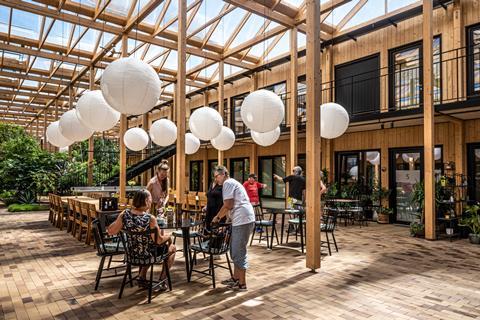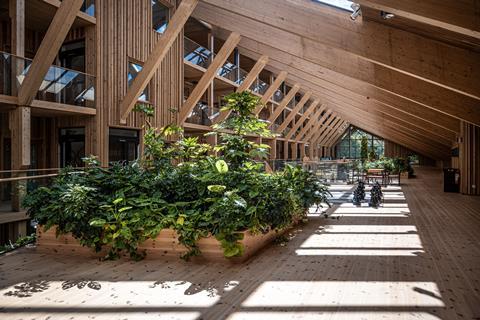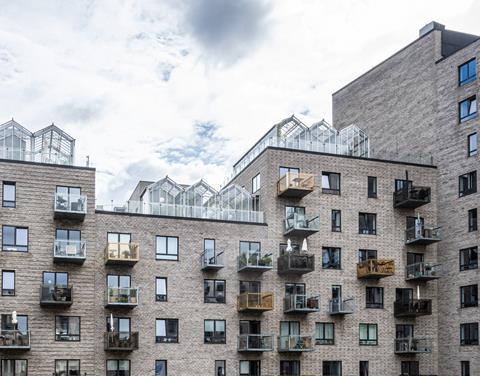Groundbreaking findings and 18 design principles emerge at pivotal time for later living housing
In the United Kingdom, the demographic landscape is rapidly changing. By 2043, it is projected that individuals aged 65 and older will constitute 24% of the population. This demographic shift underscores the urgent need for housing that caters to the specific needs of an aging population.
The English Housing Survey (2020-21) revealed a stark reality: 1.1 million older adults live in homes that do not meet the Decent Homes Standard, often grappling with inadequate energy performance, dampness, and cold conditions.

These issues not only affect the health and well-being of older residents but also have significant financial implications for the NHS and taxpayers.
In response to this pressing challenge, Cartwright Pickard and The Helen Hamlyn Centre for Design, funded in part by Innovate UK, embarked on an ambitious research project.
This Knowledge Transfer Partnership (KTP) aimed to develop principles for age-inclusive design that could set a new standard for later living housing in the UK.
The research was driven by three pivotal questions:
- What are the most effective inclusive design practices for later living environments globally?
- How can these practices be adapted and implemented in the UK context to improve housing for older adults?
- What are the key principles that should guide the design and development of future later living housing to ensure inclusivity and enhance the quality of life for older residents?

To answer these questions, the research team employed a mix of theoretical and practical methods, including literature reviews, ethnographic studies, and field visits to leading housing models around the world. They conducted interviews with hundreds of residents to identify common themes and best practices.
The following groundbreaking findings and 18 design principles emerged as a result of this research, marking the first time such comprehensive and inclusive research has been undertaken. We have summarised key parts of the design principles below.
The design principles
1. The role of ethnographic study & market research
The foundation of these principles is built on ethnographic research, emphasising a deep understanding of the daily lives and needs of older adults. This approach ensures that the design solutions are not only practical but also resonate with the lived experiences of the elderly. It is also important to create housing designs that are culturally and contextually appropriate. Minority groups in society are often overlooked
2. Connected locations close to local amenities
Selecting appropriate locations for age-inclusive housing is crucial. The sites must offer easy access to essential services, amenities, and transportation, enabling older adults to maintain their independence and social connections. This principle emphasises the importance of integrating later living communities within broader urban settings.
3. Microclimate as an integral part of the design
Designing with microclimates in mind helps in creating comfortable living conditions. The microclimate within and around the site has a significant effect on energy consumption, visual, thermal and acoustic comfort, as well as air quality inside the building. This includes considering the weather patterns, overshadowing, wind, noise and air pollution in order to incorporate features that mitigate adverse conditions, ensuring a pleasant environment throughout the year.
4. Optimise orientation and thermal comfort
Good orientation of buildings enhances natural light and ventilation, contributing to the physical and mental well-being of the residents. It also helps in regulating indoor temperatures, reducing the need for artificial heating and cooling. Window design, the percentage of glazing and orientation can all be adjusted to allow both the benefits of winter sun and avoid unwanted solar gain in the summer.
5. Enhance wellbeing by supporting natural circadian cycles
Architectural designs should support the natural circadian rhythms of older adults. This can be achieved through controlled lighting that mimics natural light patterns, promoting better sleep and overall health. This is crucial for the wellbeing of older adults.
6. A room with a view
Providing access to pleasant views and ensuring adequate ventilation are essential for creating a refreshing and healthy living environment. These elements are vital in enhancing the quality of life for older adults. As an example, windows should be designed to provide residents with a clear and unobstructed view from a seated position, positioned at a lower level from the floor so wheelchair users or those in bed can fully benefit from the views.
7. Intergenerational developments with choice of tenure
Encouraging intergenerational interaction through mixed-age communities can combat loneliness and foster mutual support. This principle promotes diverse social networks and enriches the living experience for all residents. To successfully achieve the integration of diverse intergenerational homes requires early consultation with end users.
8. Add a diverse mix of uses and amenity
Incorporating mixed-use developments that combine residential, commercial, and recreational spaces ensures that older adults have easy access to various amenities, reducing the need for extensive travel. As an example, opening the ground floor to the public will help connect the development to the local community.
9. Integrate nature and biodiversity inside and out
Access to green spaces is crucial for physical activity and mental wellbeing. Designing communal gardens and parks within residential areas encourages outdoor activities and social interaction. The green space should also have gentle paths, a de-programmed area where residents can meet, stay together and use for various activities and experiential facilities.
10. Celebrate the building entrance
A welcoming and accessible entrance helps in creating a positive first impression and ensures that older adults can enter and exit their homes safely and with dignity. Parking space for emergency vehicles and taxi drop off and parking for residents with specific mobility needs should also be provided near the entrance.
11. Design fully accessible homes with additional space
Homes should be designed with sufficient internal space to accommodate the needs of older adults, including mobility aids and other assistive devices. Spacious interiors contribute to a sense of freedom and comfort.

12. Social use of the circulation spaces
Circulation spaces, such as corridors and stairways, should be more than just passageways. They should be designed to encourage social interaction and be visually stimulating to enhance the overall living environment.
13. Design for wayfinding and perception of space
Effective wayfinding systems are crucial for helping older adults navigate their living spaces with ease. This includes clear signage, intuitive layouts, and the use of contrasting colors to aid those with visual impairments.
14. Avoid institutionalisation by design
Designing homes that avoid an institutional look and feel helps in reducing the stigma associated with aging and homes for older people. The goal is to create environments that feel aspirational and homely with a sense of belonging.
15. Support sensory perception
Considering the sensory experiences of residents is vital. This includes the use of appropriate materials, textures, and lighting to create a soothing and stimulating environment that caters to sensory and cognitive needs. All materials, textures and contrast should allow a gentle transition between spaces to minimise confusion.
16. Incorporate smart technology
Integrating technology into the home environment can greatly enhance the quality of life for older adults. This includes assistive technologies, smart home systems, and communication tools that support independence and connectivity. AI and robotics will have an increasing role in care provision in the future.
17. Embrace modularity through modern methods of construction
Utilising MMC and BIM can lead to more efficient construction processes and better-quality housing. These methods support the creation of adaptable and sustainable living environments.
18. A mix of tenures can help create a sense of community and reduce development risk
Exploring alternative tenure models, such as co-housing or rental options, can provide more flexible and affordable housing solutions for older adults. This principle encourages diverse living arrangements that can adapt to changing needs over time. Shared ownership and BTR tenures can both work well in the later living sector.
The principles summarised in brief above are not merely theoretical; they are practical guidelines that can be applied by developers, planners, architects, and operators to create more inclusive and supportive living environments for older adults.
They emphasise the importance of designing with a deep understanding of the social and physical contexts in which older adults live.
In addition, this pioneering research marks a significant milestone in the field of age-inclusive design. By addressing the unique needs and aspirations of older adults, these principles have the potential to transform the housing landscape, ensuring that our aging population can live with dignity, comfort, and a sense of belonging.
The findings from this KTP are timely and pertinent, especially considering the upcoming general election, with both major parties outlining their housing priorities.
Labour has committed to mandatory housebuilding targets for local authorities, 1.5 million new homes over a five-year period, new towns with a minumum of 40% of affordable housing, using design codes and the delivery of 150,000 social and affordable homes a year.
While the Conservatives have no mandatory housebuilding targets for local authorities, they have committed to build 250,000 new homes in Cambridge.
With this level of housebuilding due to occur in the next election combined with the fact the UK government is already seeking to improve the quality and range of housing choices for older people through initiatives like the Older People’s Housing Task Force it is imperative that the findings from this KTP are taken on board.
For more information on the groundbreaking research click


























